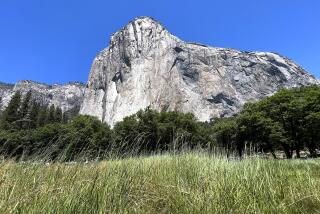National Parks Hope to Attract More Minority Visitors
- Share via
SAN FRANCISCO — For most of this century, the National Park Service has worked hard to preserve the country’s natural resources and history. But for whom?
Responding to criticism that its work force is mostly white and the vast majority of park visitors are too, the service held its first conference on diversity here.
Some 550 people from across the nation, many of them from community organizations representing blacks, Asians, Latinos and other ethnic minorities, gathered for a traditional blessing by a Native American of the Pomo tribe before attending workshops last week with such titles as: “National Parks: Places of Isolation or Inclusivity?” and “Achieving a National Park System Relevant to All Americans.”
“We need to continue our efforts internally and to work with other organizations to assure that all citizens of the United States understand that these parks are being preserved for their benefit,” park service Director Robert Stanton said in an interview.
Appointed in 1997, Stanton is the service’s first African American director. He sees a link between the relatively small number of ethnic minorities visiting the parks and the fact that only a handful of minorities work as rangers. Nonwhite visitors may feel more comfortable in the parks, he and other officials have said, if they see employees who look more like them.
Of the park service’s 15,929 permanent employees, 79% are white and 11% are black. Few of the service’s black employees serve as park rangers, where they would come into contact with the public. Fewer than 5% of the service’s work force is Latino, fewer than 3% are Native American and just 1% are Asian American.
Gillian Bowser, an ecologist at Joshua Tree National Park who is black, said her 18 years with the park service have often been lonely. There are so few black rangers, Bowser said, that “we are tokens beyond tokens.”
When she started with the service at Yellowstone National Park, Bowser said, there was only one other black on the staff of 270. Today, she is one of four blacks on a staff of 79, “and that is probably the most diverse staff I’ve served on.”
Bowser said she is encouraged by Stanton’s appointment, but frustrated that the agency has moved so slowly toward making the parks inviting to everyone.
“We are not very good about going out to people,” she said. “There is a strong tendency of the parks to promote this white, outdoorsy image. They have an image of being for upper middle class white America.”
Just two years ago, the park service’s Western regional office compiled the organization’s first list of media outlets aimed at ethnic communities and distributed it to all the parks. Park superintendents have begun to refer to the list when they send out press releases, contact reporters about stories or send notices of job openings.
The service also has begun recruiting temporary summer employees on traditionally black college campuses and in inner cities. Stanton began his own park service career more than 30 years ago as a summer hire in Grand Teton National Park.
And the service is conducting more surveys of park visitors. A 1998 survey of five sites in different regions revealed that groups of whites constituted at least 85%, and as much as 95%, of the visiting groups.
Whites constituted 95% of the groups visiting the Santa Monica Mountains National Recreation Area, the only California park surveyed. That park is near Los Angeles and large populations of minorities.
Such findings endanger the future of the 378 parks, historic sites and monuments under the service’s jurisdiction as the nation’s ethnic makeup shifts, said John Reynolds, director of the service’s Pacific west region.
“If we cannot be relevant, we will not be supported,” Reynolds said in the conference’s opening speech. “We will fade from the ‘best idea’ to ‘interesting anachronism.’ ”
Conference participant Earlice Rupp agreed, saying that fear of eventually losing congressional funding is pushing the park service to change.
“We’re talking money now,” Rupp said. “The color of interest is the color green.”
Rupp is president of the Nicodemus Historical Society. Nicodemus, a tiny, northwest Kansas town founded by emancipated black slaves after the Civil War, has been preserved as the oldest black town west of the Mississippi. The town, which still has 35 residents, was named a National Historic Site and added to the park service in 1998.
Several other sites commemorating cultural diversity have been added to the park system in the past 10 years. The Little Rock Central High School National Historic Site marks the previously all-white school that was integrated by nine black students in 1957. The Tuskegee Airmen National Historic Site in Alabama preserves Moton Field, the training base for an all-black air corps unit of World War II.
Because of its low rate of staff turnover and funding shortages, the park service faces difficulties in aggressively recruiting minorities and mounting costly outreach programs, officials say.
Bowser, the ecologist, said she would like to see the service set up a mentoring program for minority recruits aimed at keeping them in the service once they join.
“The danger,” Bowser said, “is that this ends up just being a conference.”
More to Read
Sign up for The Wild
We’ll help you find the best places to hike, bike and run, as well as the perfect silent spots for meditation and yoga.
You may occasionally receive promotional content from the Los Angeles Times.






